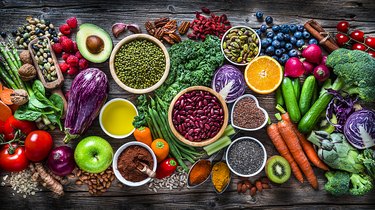
Your body needs energy to function, from breathing to thinking to exercising. One point missed in the battle between carbs and fats (or lipids) is the fact that your body can use either of these macronutrients for energy and, if you eat too many, they'll get stored in the same way.
Lipid Energy Storage
Video of the Day
Gram for gram, lipids — like butter and oils — provide more than twice as many calories as other macronutrients (both carbs and protein), at 9 calories per gram, according to the Cleveland Clinic. The more calories a food contains, the more energy it can provide to the body. But any excess calories that do not need to be used will be stored as body fat, regardless of the source.
Video of the Day
According to the U.S. National Library of Medicine, additional calories from fat are stored as triglycerides within your fat cells. When your body needs this energy, the triglycerides will be released and carried to your tissues. "Fat is like your body's savings account," says Jen Lyman, RD, a Missouri-area dietitian. "When you eat fat, it gets stored right away to be spent later."
Typically, lipids aren't the first source your body turns to when it comes to choosing energy. Rather, lipid energy storage is drawn on once carbohydrates (which are stored as glycogen) are depleted, according to Michigan Medicine, at the University of Michigan.
The recommended fat consumption for adults is 20 to 35 percent of your total calories, states the Cleveland Clinic. By type of fat, the recommendations are:
- Monounsaturated fat: 15 to 20 percent.
- Polyunsaturated fat: 5 to 10 percent.
- Saturated fat: Less than 10 percent.
- Trans fat: 0 percent.
Read more: 15 Healthy Fat-Rich Foods to Add to Your Diet
Carbohydrate Energy Storage
Enjoy your grains, fruits and vegetables — foods that contain carbohydrates, which in turn create energy. According to the American Heart Association, when these foods are consumed, they get broken down into simple sugars, which are then absorbed into the bloodstream. As your blood sugar (glucose) level begins to rise, your body releases the hormone insulin to move the sugar to the cells to be used as energy.
Not all carbohydrates are created equal, though. The simple sugars found in high-calorie desserts and sugar-sweetened beverages are digested very quickly, leaving you feeling hungry again shortly after eating them. Complex carbohydrates, from whole-grain foods, for example, take longer to digest because it takes longer for your body to break them down, causing you to feel full longer.
According to Michigan Medicine, if all the glucose in your blood is not needed for energy, it will be stored in your fat cells or in your liver as glycogen.
"Carbohydrates are like a checking account — they're easy to access for quick energy," says Lyman. But eat too many and they'll be added to the fatty savings account. "If you fill up the carbohydrate storage in your muscles and liver and still have carbohydrates left to store, then they'll get turned into fat," she explains.
Transferring excess glucose to either fat cells or the liver allows blood sugar to be level and return to a normal range, explains Michigan Medicine. A normal blood sugar reading should be between 70 and 120 milligrams per deciliter.
If blood sugar levels drop below that range, your body can react in different ways. It can call for the release of the hormone glucagon from cells in your pancreas, which signals your body to create more glucose from glycogen in your muscles and liver. When glycogen stores are used, your body will tap its fat stores for energy.
The 2020-2025 Dietary Guidelines for Americans recommend consuming 45 to 65 percent of your total daily calories from carbohydrates. Choose options such as whole-grain foods, starchy vegetables, legumes and beans.
- Cleveland Clinic: “Fat and Calories”
- Cleveland Clinic: “Fat: What You Need to Know”
- U.S. National Library of Medicine: “Triglycerides”
- Jen Lyman, RD, New Leaf Nutrition, Overland, Missouri
- Michigan Medicine, University of Michigan: “Carbohydrates, Proteins, Fats, and Blood Sugar”
- American Heart Association: “Carbohydrates”
- USDA: “2020-2025 Dietary Guidelines for Americans”